Mank? Refrozen Death Cookies? Crud — wait, how is that different from “Chop?” Reading ski reviews — or just talking to a seasoned skier — can sometimes feel like interacting with a foreign language (and a special shout out to all of our readers whose primary language isn’t English — Thank You for putting up with us, and for your polite suggestions to produce a Glossary.)
So in the interest of speaking the same language, getting on the same page, and making our reviews more useful to everyone, here are some terms we use to describe the snow conditions we test in, some general skiing styles and techniques we refer to, and a few important elements of ski and snowboards’ on-snow performance that we frequently compare and contrast in our reviews and comparisons.
Take a look…
Snow Conditions & Terrain
Chalk: Dry, easily edgeable snow that often forms when it’s consistently cold and often windy. Chalk feels like, well, chalk. You’ll most frequently find it in steep, off-piste terrain, and a nice, chalky, steep run can be tons of fun since you can dig your edges in when needed, the snow is not grabby, and it’s more forgiving than refrozen snow. If it’s chalky, you’ll often find yourself blowing up big clouds of spray while sliding down the slope. Some of the best chalk can be found on steep, north-facing slopes (or south-facing, in the southern hemisphere) in the springtime, since it warms up just enough to be softer than mid-winter chalk, without going through a full thaw-freeze cycle that results in brutally firm morning conditions.
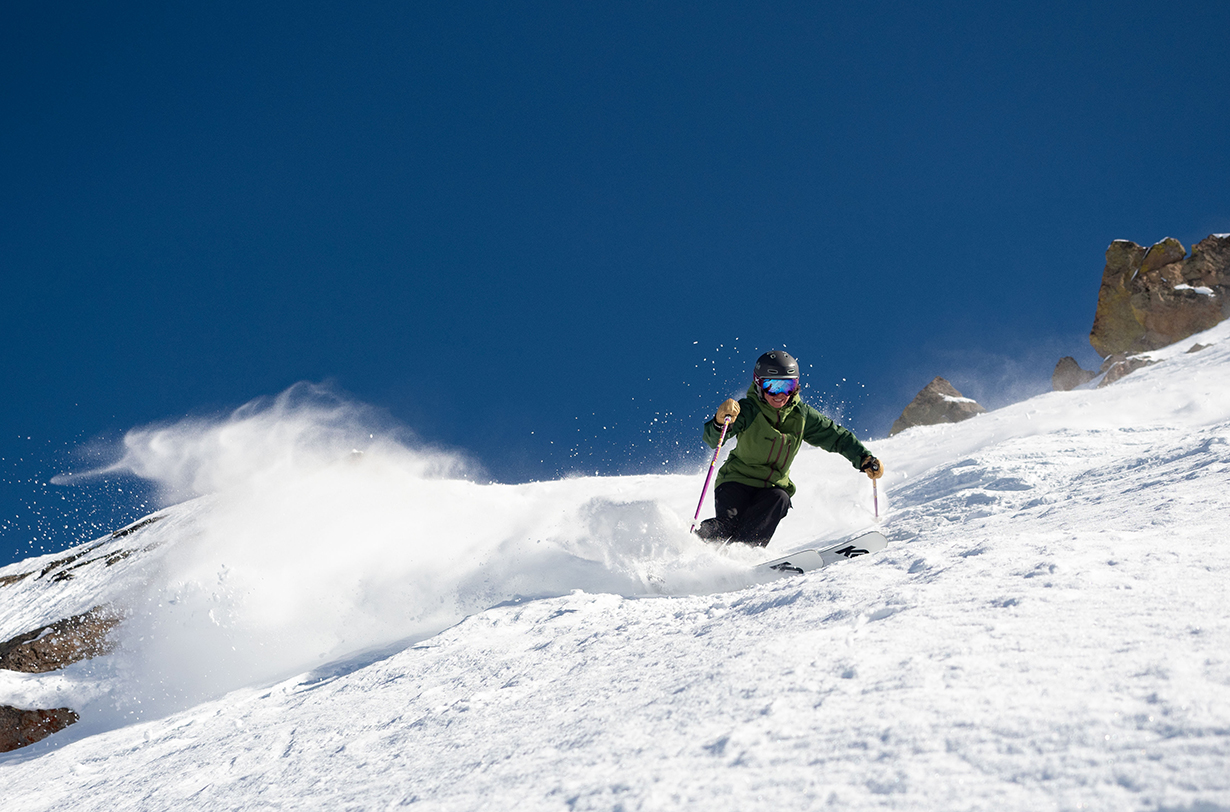
Chop: Powder after it’s been skied and cut up. Shallow chop (3-5” of tracked-out snow) isn’t much to contend with when the snow is light and fresh. But late in the day after a big storm, blasting through trenches and 12-24” deep pockets of powder can really test a ski’s stability — and your leg strength. That said, skis that are stable in chop (typically heavy and stiff ones) can make these conditions an absolute blast, since the snow is still fairly soft and forgiving, but you’ve also got limitless piles of chop to jump off. In reality, most “powder days” in a ski resort will consist of more chop skiing than untracked pow turns.
Corn: Found in the spring, corn is created during repeated thaw-refreeze-thaw cycles. You’ll typically find it an hour or so after the sun hits some refrozen snow on a warm spring day, and it makes for incredible skiing since it’s supportive enough to carve, but also extremely forgiving. Its consistency is somewhat similar to canned corn — soft and mushy up top, with corn-sized granules, and a firmer base underneath. Many people will put corn near the very top of the list when it comes to favorable snow conditions. It’s fairly rare to find true corn in a resort setting; the best corn forms on untracked backcountry spring lines, since ideal corn doesn’t form as easily when it gets skied during the thawed period of its formation cycle.
Crud / Mank: First you have untracked powder. Then you have fresh snow that gets chopped up, and after that chopped-up snow consolidates, gets warmed by the sun, and then hardens overnight, you have “crud.” Heavy, grabby, often hard & set-up clumps of snow. The heavier and wetter that “crud” gets, the more inclined we are to call it “mank.” If that set-up snow is colder & drier, that’s “crud.” Snow doesn’t necessarily need to warm and harden overnight to be considered crud; chop at the end of a resort powder day can often be considered crud once it’s been skied on by enough skiers, which is why we often include a section in ski reviews title “firm chop / crud.”
(And if it’s late in the season and you’re dealing with warm, slushy days and below-freezing nights, a similar freeze-thaw cycle can produce the dreaded “Coral Reef” or “Death Cookies,” which are basically the harshest, most extreme versions of crud.)
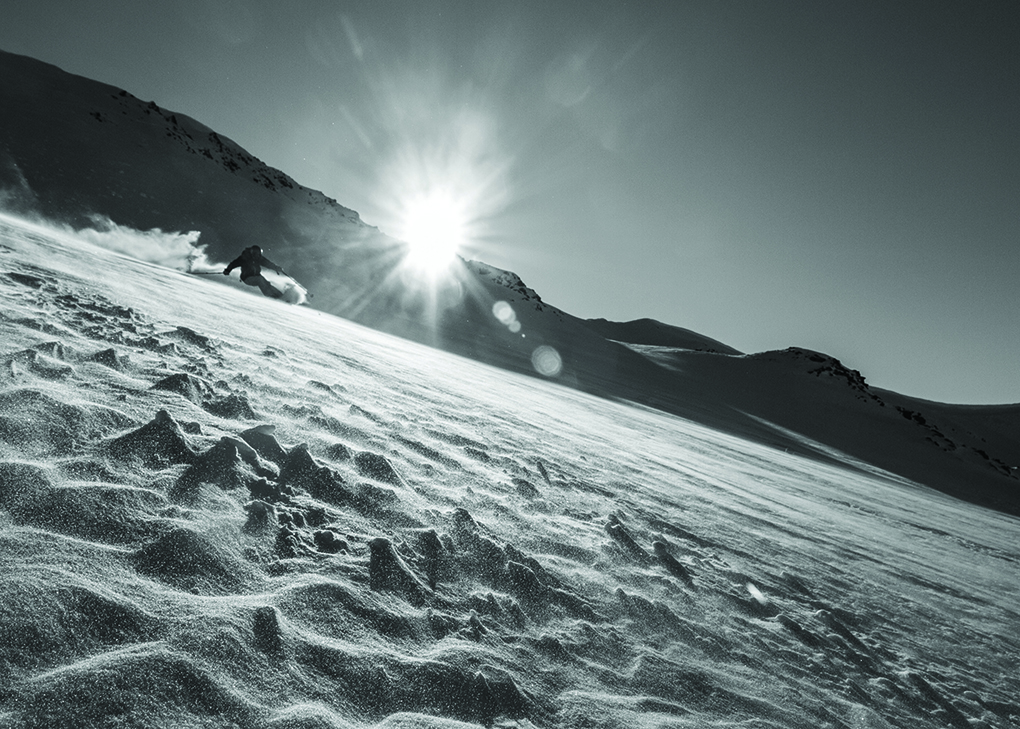
Coral Reef / Re-frozen Conditions: Have you ever seen a coral reef? Have you ever skied re-frozen snow that looks like (and sort of feels like) a coral reef? It’s brutal, and no ski handles it well. Death Cookies, Frozen Popcorn, Sh!t F$*@k snow, whatever you call it, if you spend a lot of time skiing it, expect to invest in a good physical therapist (and maybe some very heavy skis).
Crust / Breakable Crust: Snow that has a firm layer on top (often from 1-5″ / 2.5-12.5 cm thick), then a softer layer below it. If that crust is super solid, it’s typically easier to deal with — you just ski along the firm surface. If that crust isn’t that solid, you have breakable crust, and the skiing will be pretty interesting / more-or-less painful since you’ll frequently be punching through the crust and getting your skis caught up in / under it.
Dust On Crust: Just what it sounds like — an often very thin layer of soft, fresh, or wind-loaded snow on top of a very firm base. If the “dust” is thicker, this could make for fun skiing. But more often than not, “dust on crust” refers to a tiny layer of soft snow on top of a super firm layer, which gives you the impression that the snow is forgiving when it is, in fact, very much not the case.
Firm, Smooth Snow: This is a more general description that could refer to a cold groomer that has been skied a bit and erased of its groomed corduroy tracks, or off-piste / ungroomed conditions that are pretty hard but consistent in their smooth texture. These conditions will test the limits of a ski’s edge hold.
Frozen Chicken Heads: Rock-hard, frozen clumps that stick up off the snow a couple of inches. They’re usually sitting on old, firm, wind-affected snow. Similar to coral reef.
Groomers / Piste (General): Runs that have been cleared of trees and groomed (typically by a snowcat) to create an open run with smooth, compacted, consistent snow. Depending on temperature, humidity, time of day, and the skill of a mountain’s grooming staff & machinery, the surface conditions of groomers can vary quite a bit, but the main point is to have a consistent surface on which to carve nice turns. “Piste” is the French term that generally refers to the same concept, with “off piste” referring to the terrain and conditions on a mountain that are not groomed.
Groomers — Roughed-Up: We also call them “end-of-the-day” groomers, when the groomed runs have been beaten up throughout the day by skiers and the corduroy is gone. If a bit of snow fell the night before, you might have tons of mini-moguls dotting the run — little soft piles formed by wind & skiers making their turns. On cold, man-made snow, roughed-up groomers often consist of icier sections where many skiers have been making turns, and then loose, almost graupel or gravel-like piles of snow next to those.
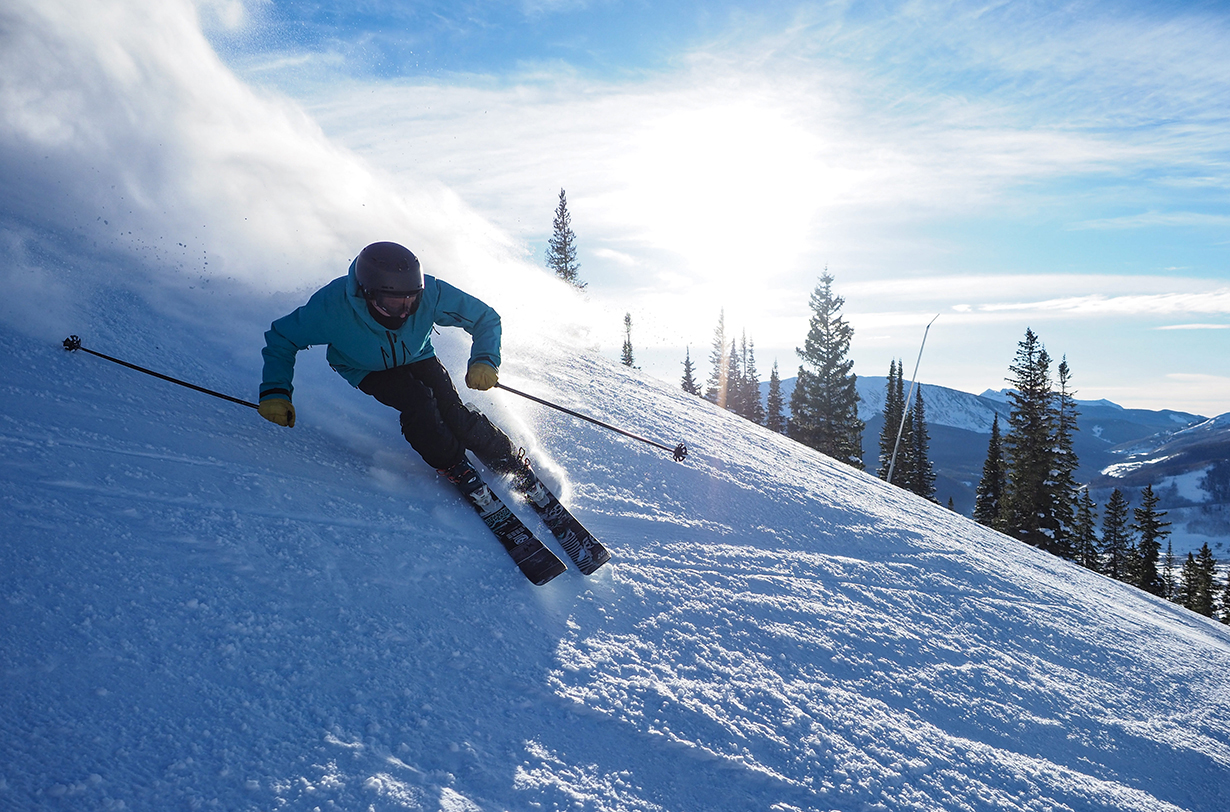
Groomers: Smooth & Consistent: Nice, fresh corduroy; groomers that haven’t been roughed-up by skiers pushing snow around as they skid their turns. Depending on your preferences, on a nice pair of frontside skis, fresh groomers can rank up there with the pleasure of skiing deep pow.
Groomers: Bulletproof: Rock-hard Ice. Good luck getting your ski edges to dig in and bite. If you’re not on race or at least well-tuned piste-specific skis, the best you can probably hope for is a predictable, controlled skid.
Mashed Potatoes: See “mank.” Heavier, wetter, gloppy, warm snow that’s been turned up / tracked out. Once that snow starts to get really wet and heavy and setup, it stops being mashed potatoes and moves into the “Cement” realm.
Moguls: Mounds of snow with troughs in between that form in off-piste / ungroomed terrain because of skiers making lots of shorter, skidded turns. These can vary a lot in terms of size, spacing, and snow conditions. Moguls that are widely spaced with shallow troughs and broad mounds are much easier to navigate than tightly spaced ones with deep troughs and giant, car-sized mounds.
Off Piste: This simply describes any terrain and conditions that are not groomed. Since off-piste terrain isn’t groomed, the snow conditions are constantly changed by the weather and the skiers skiing them.
Powder: Freshly fallen snow, and the thing that many skiers spend their entire lives seeking. Powder can vary a lot in terms of consistency, which often comes down to wind and temperature. In warmer climates, powder is often denser, wetter, and/or heavier, while colder temps lead to “blower” or “champagne” powder that is extremely low-density and makes for pretty effortless skiing as the snow itself provides very little resistance when heading down a slope. Wind will move fresh powder and wind-deposited snow is often denser than freshly fallen snow (see below).
Sastrugi: Those beautiful wind-erosion patterns that form in firm, wind-affected snow. Nice to look at, terrible to ski through.
Slush: Melted snow that’s soft and wet. Like skiing on a smoothie / milkshake. Slush varies in depth and consistency; earlier on a warm spring day it’s shallower and more reminiscent of “corn,” while it typically gets deeper and heavier the longer it’s out in the sun.
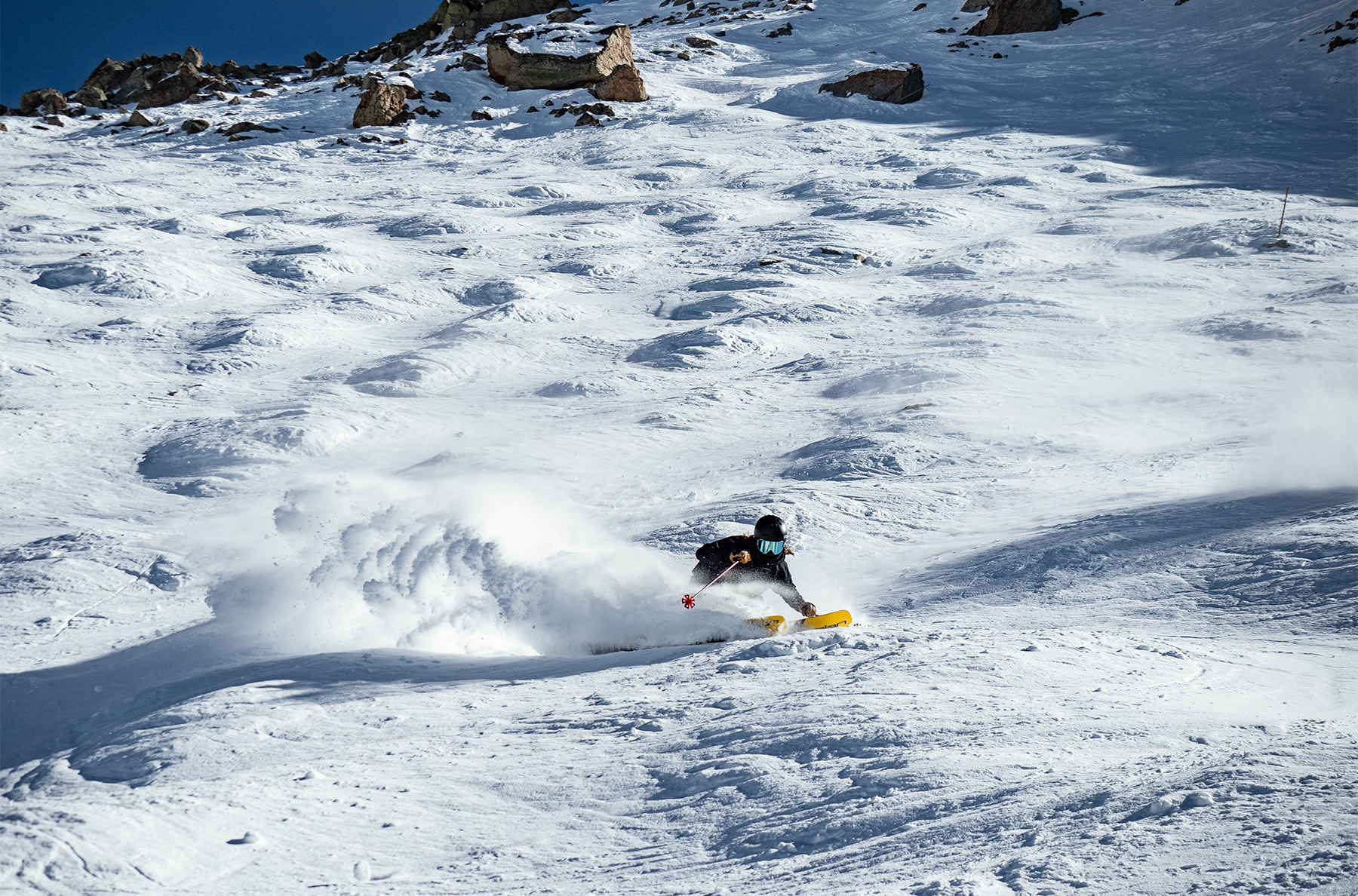
Slush Bumps: Wonderful. For some of us, slush bumps rank just after (1) deep pow, (2) unexpected stashes of wind-deposited snow, (3) smooth, creamy, wind-buff, and just ahead of or just after perfect corduroy.
Sun Cups: Generally found late in the spring and summer (and the fall before the next season’s snow has stacked up), sun cups form when snow is repeatedly exposed to sun and above-freezing temperatures over many days. They’re bowl-shaped depressions in the snow with thin ridges and wider concavities. If you refuse to put your skis away in the summer (e.g., ski at least once every month of the year), you’re probably well aware of how challenging they can be to ski, though if they’ve got thick layer of slush on top, they can still make for a good time when most skiers are thinking about more typical summertime activities.
Tight Terrain: This is a general term to describe off-piste terrain with lots of obstacles that require lots of shorter turns. We’ll often use “tight terrain” to refer to a ski’s performance in moguls, trees, steeps, and any other off-piste terrain that requires a similar skiing style with lots of on-the-fly adjustments and few long, sweeping turns.
Upside-Down Snow: Snow that is heavier on the surface, then drier and lighter below. “Punchy” snow somewhat similar to breakable crust, but with a less consolidated surface layer.
Variable Conditions: An inconsistent mix of firm and soft snow. Could be a firm, maybe wind-scoured base with some looser soft snow sitting on top, or could be a mix of chunky, icy stuff and softer, gloppy snow. One of the more challenging conditions to ski fast in, and a great test of a ski’s stability.
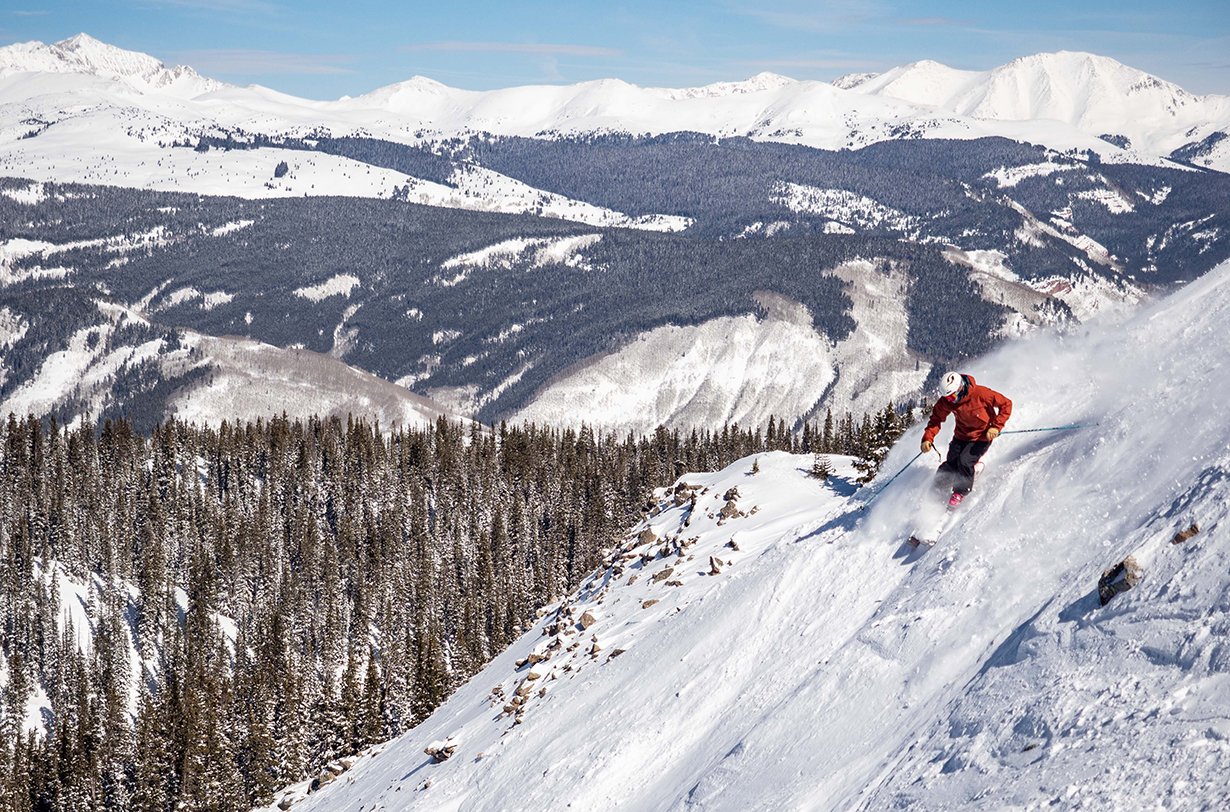
Variable Terrain: When downed trees, large boulders, cliff bands, etc. are the primary cause of the significant undulations / variations in the snow surface.
Wind-Deposited: Denser pow (and if you’re lucky, deep pow) that got blown over from some other section of the mountain to create a nice little pow stash. Wind-deposited pow can turn a mostly firm day into a surprise mini-pow day if you find the right run / aspect where the snow’s collecting. Wind-deposited snow is often a bit denser and less “fluffy” than freshly fallen powder. To find wind-deposited snow, look around for rocks, trees, and snowbanks that have been stripped bare on one side and have smooth mounds of snow on the other.
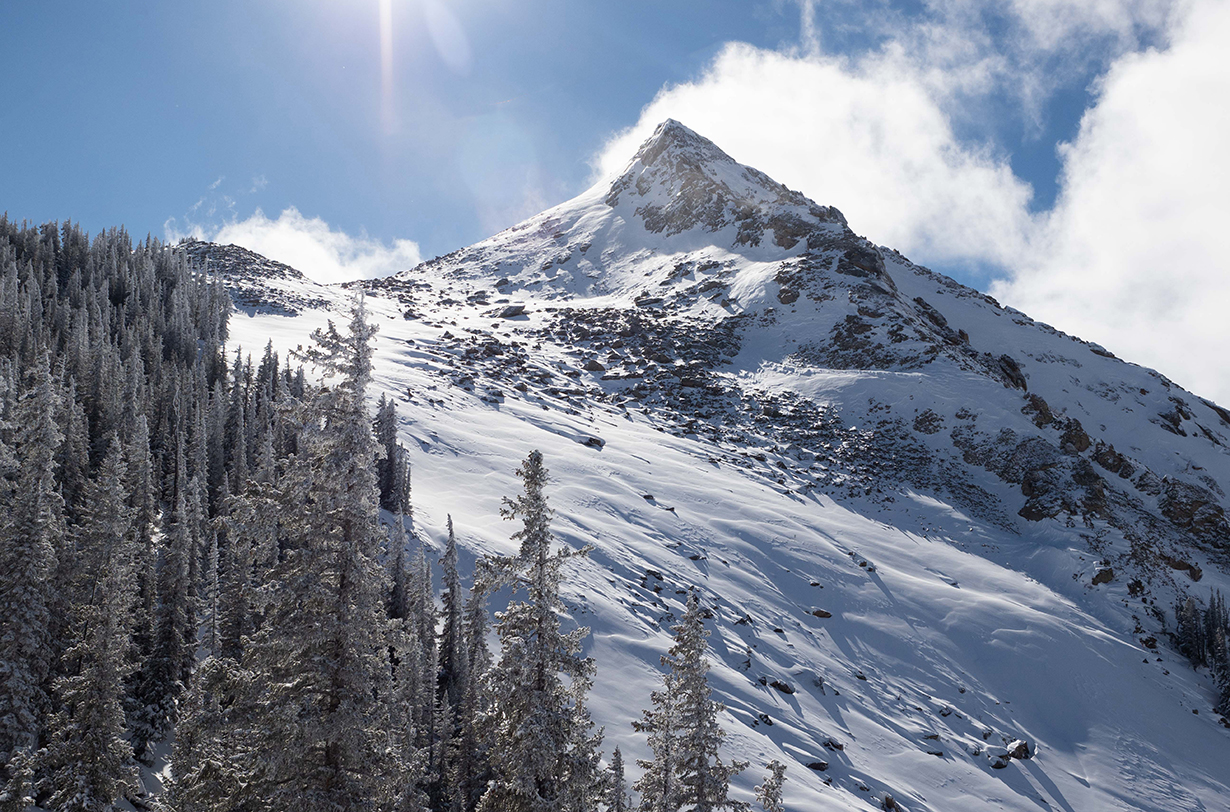
Wind-Scoured: Snow that’s been stripped thin and firm by the wind. It’s not necessarily icy snow (it can still be grippy), but this usually means that someone, somewhere else is skiing a bunch of wind-deposited loveliness.
Wind-Buff, Cream Cheese: Very dense, often a little wet, usually wind-affected snow that may only let your skis sink a few inches into it, but it’s smooth and super rippable. Buttery, cream-cheese snow makes for a plush ride while also making it easy to tell exactly what your skis are doing. Finding and skiing creamy, buttery wind-buff is so good and fun, it can almost make deep-ass pow seem overrated.
Skiing Experience Levels, Styles, & Techniques
Skier Experience Levels:
There are many different ways to think about and define skier experience levels. So we are not saying this is the best or definitive way, but here’s how we think about them:
Beginner: You are brand-new to skiing, and / or you are still working on getting comfortable on beginner “green circle” runs (or in Europe, “blue circle” runs).
Intermediate: You are comfortable on all “green circle” and “blue square” runs (or in Europe, “blue circle” & ”red circle” runs). You might even be picking your way down some ‘black” runs, though you aren’t comfortable skiing many of them.
Advanced: You can ski most black runs, on-piste and off-piste, with confidence and relatively good technique in many conditions.
Expert: You have outstanding technique, and are able to ski most black and double-black runs with confidence and good form in all conditions.
Pro Skier / Comp Skier: You currently ski — or have formerly skied — at the highest levels of the sport. Your skill and experience level would consistently put you among the very best skiers at any mountain.
Skiing Styles & Techniques
Active / Dynamic Style (“Light On Your Feet”): When we talk about a “dynamic” or “active” style, we’re basically talking about skiing with more finesse than brute force. A “dynamic” style typically means you ski “lighter on your feet” — rather than skiing straight through rough snow, you tend to find lines that let you avoid big impacts by making lots of quick adjustments mid-line. You tend to get your skis in the air often, whether that be on jumps or just when skiing through variable terrain (e.g., moguls, trees, steeps). A less dynamic style will often mean you tend to keep your skis planted on the snow and won’t be making as many minute, quick adjustments. As a result, people who do not ski very dynamically tend to generally be better served by heavier skis that do a better job of blasting through everything and muting out harsh impacts. Dynamic / active skiers tend to prefer skis with more energy or pop and that are often a bit lighter since they make it easier to make quick adjustments, and if you’re skiing with an active style, you won’t need quite as damp and stable of a ski.
Butter: Bending the tips or tails of your skis while sliding on the snow, usually during a rotation, so that only the tips or tails of your skis are touching the snow, with the rest of the ski in the air. E.g., during a “nose butter,” you’d be sliding on and bending the tips and shovels of your skis, raising the tails of your skis off the snow. Butters can be done on flat ground, off rollers, before or after jumps, or just about anywhere. In general, softer skis tend to be easier to butter since they’re easier to bend, and skis with deeper rocker lines and more tip and tail taper also tend to be easier to butter since they don’t “catch” or “grab” the snow much during the rotation of a butter.
Directional: A directional skier is someone who does not ski switch, and who is often less commonly making slashed / slarved turns. They ski with a forward, more race-inspired stance and drive the front of their skis through their turns. A directional ski is one that supports or encourages this style of skiing.
Faceshot: When you’re skiing through fresh snow and the snow from your skis / board flies into your face. Despite the fact that it plasters you in cold snow, many people live to score faceshots since they’re a sign that the snow is nice and deep. When getting faceshots, some describe the experience (sarcastically or not) as entering the “whiteroom,” getting “pitted,” or a number of other goofy euphemisms.
Freestyle / A “freestyle-oriented approach to terrain”: You’re looking for cat tracks to launch off, jumps to hit on the sides of runs, cliffs and cornices to spin off — you have a more freestyle-minded approach to the mountain. “Jib” is in your vocabulary.
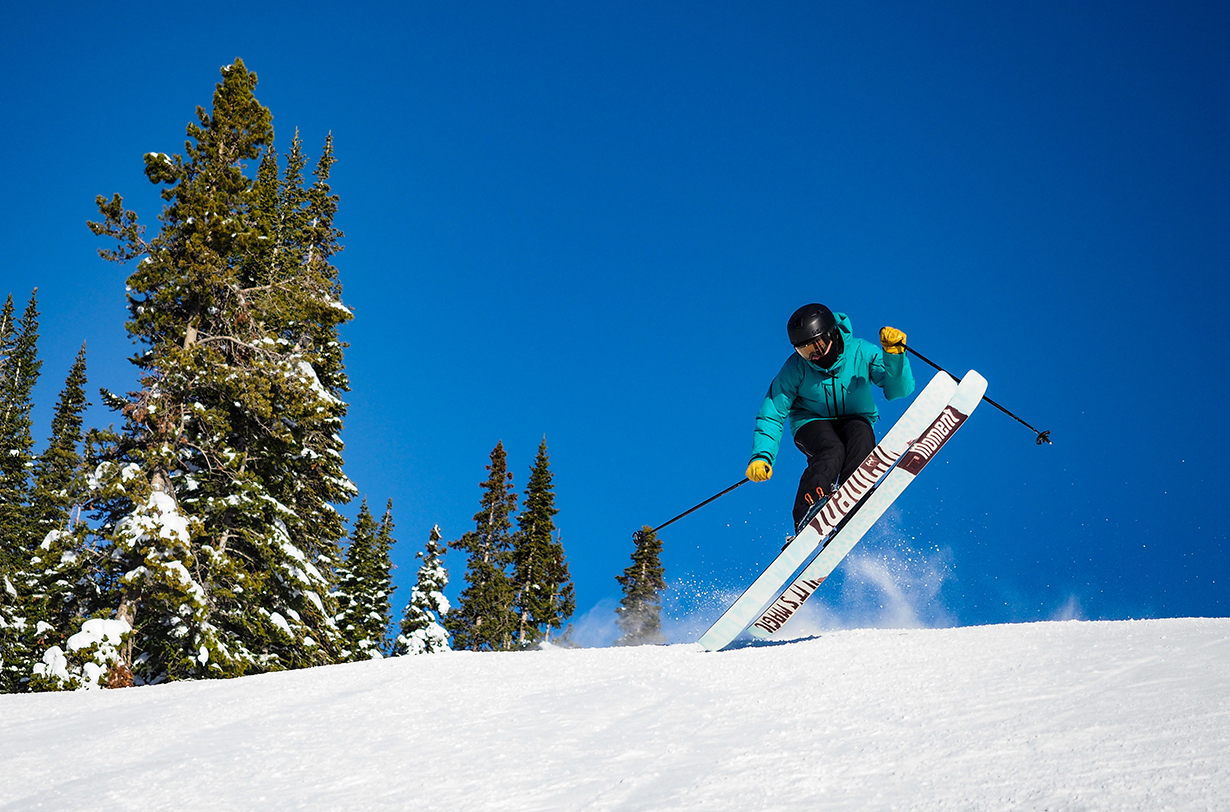
Jib / Jibby: Very broad terms that mean to get flippy and/or spinny. A “jib ski” is one that makes hitting jumps and throwing spins and tricks around the mountain easier. Generally, this involves a more relaxed, flowy style of skiing that uses the ski’s flex to smear around on and pop off terrain features. A jump on the side of the run that presents a tree to tap in the air makes for a good “jib.” Boring skiers like to complain about “jibbers,” perhaps out of jealousy since they seem to be having so much fun.
Playful: Can refer to both a skiing style and how a ski feels on snow. In terms of skiing style, “playful” is a more general term than “jib” or “freestyle;” you can ski playfully without throwing tricks, hitting rails, flipping, etc. Someone who skis playfully tends to ski with more of an active / dynamic style (see below), often slides and slashes their turns, likes to get in the air often, and may throw tricks and/or ski switch. In terms of a ski being “playful,” we use that word to describe skis that are (1) easy to release from a turn / slarve, (2) that produce energy when you flex them, (3) are easy to flick around in the air, (4) feel balanced in the air (often due to a more forward, centered mount point), and/or (5) ski switch well. Many skis are playful in some of those aspects, but not in others, which is why we often expand on a given ski’s “playfulness” and detail in which specific ways it feels playful.
Skiing Stance (Forward vs. Centered): We talk about this a lot, since it’s one of the most important things to consider when looking for new skis. Everyone’s skiing stance is different, but we primarily divide them into more “forward” or more “centered.” A skier who skis with a forward stance is more likely to be a directional skier; they drive the front of their skis by pressuring their shins into the front of their boots, and match that with a generally more forward-leaning position through their knees, hips, shoulders, etc. This is the more traditional stance that originally stemmed from ski racing, and most skis are designed with this stance in mind. If you ski with a more centered stance, you’re generally not putting as much pressure on the front of your boots. Because of the dynamic nature of skiing, almost everyone is constantly switching between these two broad styles, but it’s important to note whether you’re generally trying to stay in a more forward or more centered stance, since certain skis will feel more or less intuitive as a result. Most notably, skis with more rearward mount points (say, -7 cm and farther back from the true center of the ski) will feel more intuitive when skied with a forward stance, whereas skis with more forward mount points (say, -6 cm to 0 cm from the true center of the ski) will typically feel more intuitive when skied with a more centered stance. These are not hard-and-fast rules, though, which is why we almost always touch on what sort of stances feel natural on a given ski.
Skiing Switch: Skiing backward. (Hopefully, you meant to be skiing backward.) Sometimes called skiing “fakie,” though that’s much more common when referring to snowboarding.
Slarve / Slide / Release / Pivot / Slash / Drift / Skid: Picture this: you’re flying down the mountain in soft, deep pow, laying over a carved turn on edge and then you roll your ankles down the fall line, letting your skis break free in a long, controlled slide with your skis perpendicular to the fall line. Though “slarving” originally applied to skiing big lines in pow, it can be done in firmer, smooth conditions too, or even on a groomer. If you had to split the nearly limitless variety of turn shapes and styles you can make on skis, “slarving” is on the opposite end of true “carving”; carving is more about using the ski’s sidecut to make clean turns on edge, whereas slarving involves “releasing” or “breaking free” from the arc that a ski would naturally make on its own and instead forcing it into a wider variety of turn shapes. Most skiers use slarving (or “pivoting” or “slashing” etc.) to manipulate their turn shapes to suit the terrain, since you can rarely carve clean, perfect-looking, railroad-track-style turns all over the mountain. In general, skis with more rocker and taper (particularly through the tail), longer sidecut radii, and/or softer flex patterns are easier to break free / release into a drifted slarve or slash. These traits often come at the expense of overall carving performance.
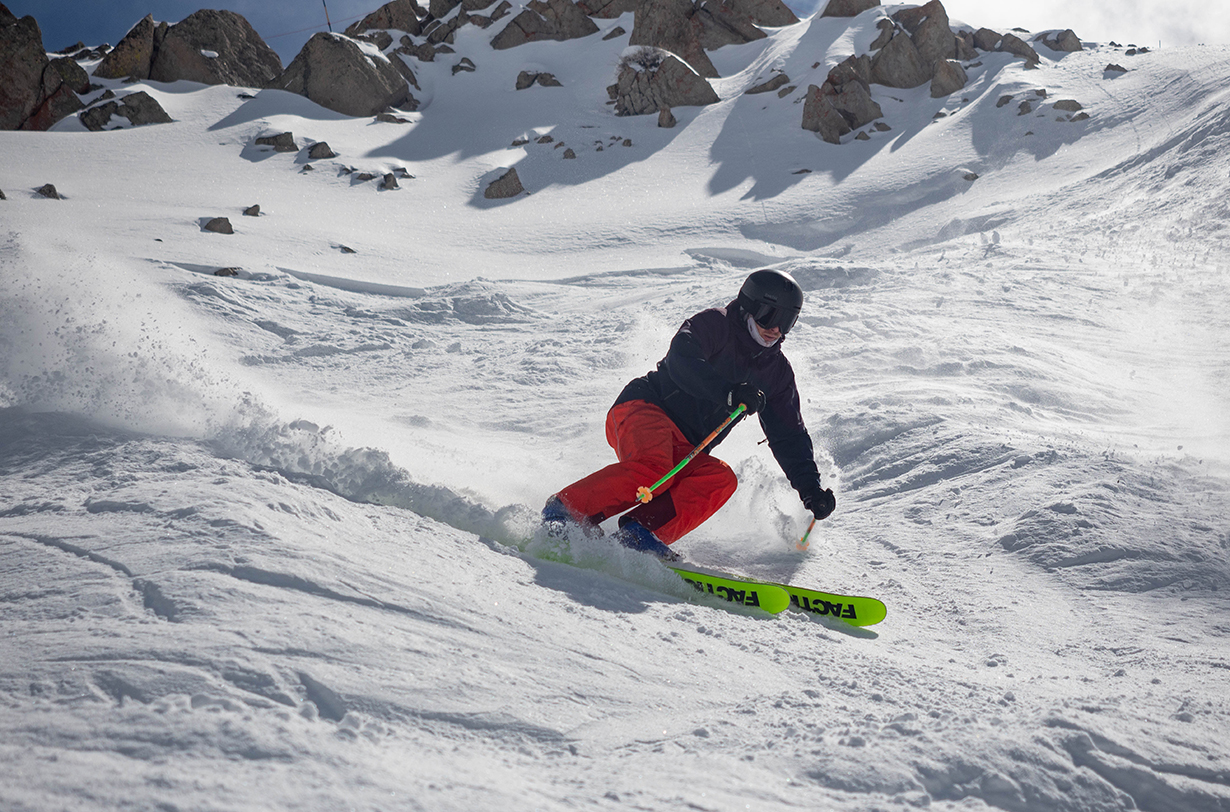
Terms Related To Ski Design, Materials, & Performance Traits
“50/50”: A term we use to describe products designed for both backcountry ski touring and lift-accessed, resort skiing. “50/50” products are generally lighter than inbounds-specific or “alpine” products, and heavier than dedicated touring products.
Swing Weight: How heavy / sluggish or light / quick a given ski feels, particularly at its tips. A ski with a high swing weight will be more difficult to flick around from your ankles, which is most noticeable in the air or when skiing tight trees, steeps, and mogul runs. Skis with heavily tapered tips typically have lower swing weights because the widest (and heaviest) point on the ski is moved closer to the middle of the ski. Swing weight directly affects how nimble / agile / quick a ski feels.
Taper (Tip / Tail Shape): When the widest point of a ski’s tip or tail is shifted closer to the center of the ski, and the material beyond it is “tapered” inward toward the end of the ski. Most modern skis wider than ~95 mm at the waist have at least some tip and/or tail taper, while narrower skis do not tend to have much taper since it decreases a ski’s effective edge on firm snow. The Armada ARGII is an example of a ski with extreme tip and tail taper. More tip and tail taper generally leads to a looser, more maneuverable ride, especially in softer, deeper, and/or more variable snow conditions, and it also reduces swing weight (all else being equal). The downsides are typically reduced carving performance (often in terms of edge hold and ease of turn initiation), as well as stability in chop and crud.
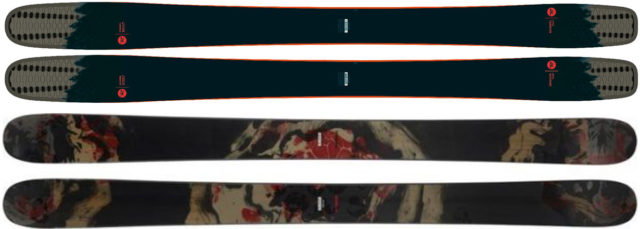
Titanal: A lot of ski companies refer to titanal as “Metal” or “Ti.” Some will falsely call it “Titanium.” Titanal is the name of an aluminum alloy made by AMAG Austria Metall AG and is used in the layups of some skis to make them more damp, stable and/or torsionally rigid — it is not titanium, and almost no skis are being made with actual titanium (some of Atomic’s skis being some of the very few exceptions we could find). Titanal can be used in the form of just a small piece under the bindings purely for increased binding-screw-retention, as multiple layers that extend across a ski’s entire length and width, or many other implementations in between. While Titanal offers performance benefits and drawbacks, it’s only one piece of the complex puzzle that is ski design — some skis that feature Titanal have similar performance traits, but there is a HUGE variety in terms of how Titanal is implemented and how the resulting skis perform.
Damp / Damping: Not relating to how wet something is, but instead refers to how well a ski “mutes out” or decreases vibrations. A really damp ski (e.g., a World Cup GS ski) will feel almost glued to the surface of the snow, even when skiing fast in firm, rough conditions. A ski that’s not damp (e.g., a lightweight touring ski) will get knocked around a lot, can feel “twitchy” in rough snow, and overall will require more skier input and focus to keep it tracking in the right direction while skiing fast in challenging conditions. Overall, heavier skis tend to be more damp than lighter skis. For more, see “suspension.”
“Rocker” Terminology: For more about Splay, Rocker Lines, Traditional Camber, Reverse Camber, etc., see our Rocker 101 article.
Power Transfer (in regard to ski bindings): How efficiently movements — especially smaller ones — transfer from the boot, to the binding, to the ski. For example, poor power transfer can lead to a vague feeling through the tail of the ski when breaking it out of a carve in a skidding maneuver. On the other hand, excellent power transfer can lead to a more precise and connected feeling when initiating a carved turn. Most alpine bindings provide excellent, and very similar power transfer, while touring bindings (particularly “pin” / “tech” bindings) provide notably worse power transfer than alpine bindings.
Poppy / Energetic / Lively: We use all three of these terms to refer to skis that rebound / bounce back when you bend them. This could be after the apex of a hard-carved turn on a groomer, or when flexing the ski before the takeoff of a jump or drop (in order to get more air), or really any other time you’re flexing the ski and it then returns to its natural, straight shape. How poppy a ski feels depends on a lot of things, including how stiff the ski is. Certain skis (e.g., Fischer Ranger 102 FR & Faction Dancer 2) are quite stiff and they might not feel poppy / energetic to smaller or less aggressive people who aren’t able to bend them very much, but they can feel very poppy to stronger / bigger skiers who can bend them. Conversely, softer skis like the Line Sakana and Season Kin are very easy to bend and feel poppy even without much force / input from the skier, though they feel less poppy to stronger, bigger, and/or more aggressive skiers since the ski is not stiff enough to “push back” against those skiers’ strong physical input. Skis that are not poppy are sometimes called “dead,” but a ski can be both energetic and damp, which is why the details of our reviews are important.
Suspension: This is a term we use a lot, and while it’s not something you’ll see in all ski reviews or descriptions, we think it’s an extremely important aspect of on-snow performance. In short, we use it similarly to “damping,” but we think “suspension” goes a bit further in terms of describing a ski’s ride quality. When we talk about a ski’s suspension, we’re talking about how it deals with and reacts to impacts and vibrations from the snow. Skis with excellent suspension do a really good job of absorbing and managing harsh vibrations from (typically firm and/or rough, bumpy) snow. Those skis are typically heavy. Skis that offer poor suspension will transmit a lot of feedback from the snow to your body, resulting in a harsher-feeling ride quality and a generally less stable, composed, and pleasant experience on firm, rough snow.
Engaging: We’ll often discuss whether a ski is engaging at slow speeds or needs higher speeds to be most enjoyable. Generally, skis that are engaging at slower speeds are softer, lighter, and/or have tighter sidecut radii, whereas those that are engaging (or “come alive”) at higher speeds are typically stiffer, heavier, and/or have longer sidecut radii. A more engaging ski can make lower-angle terrain and slower speeds much more fun, but the compromise is typically reduced high-speed composure.
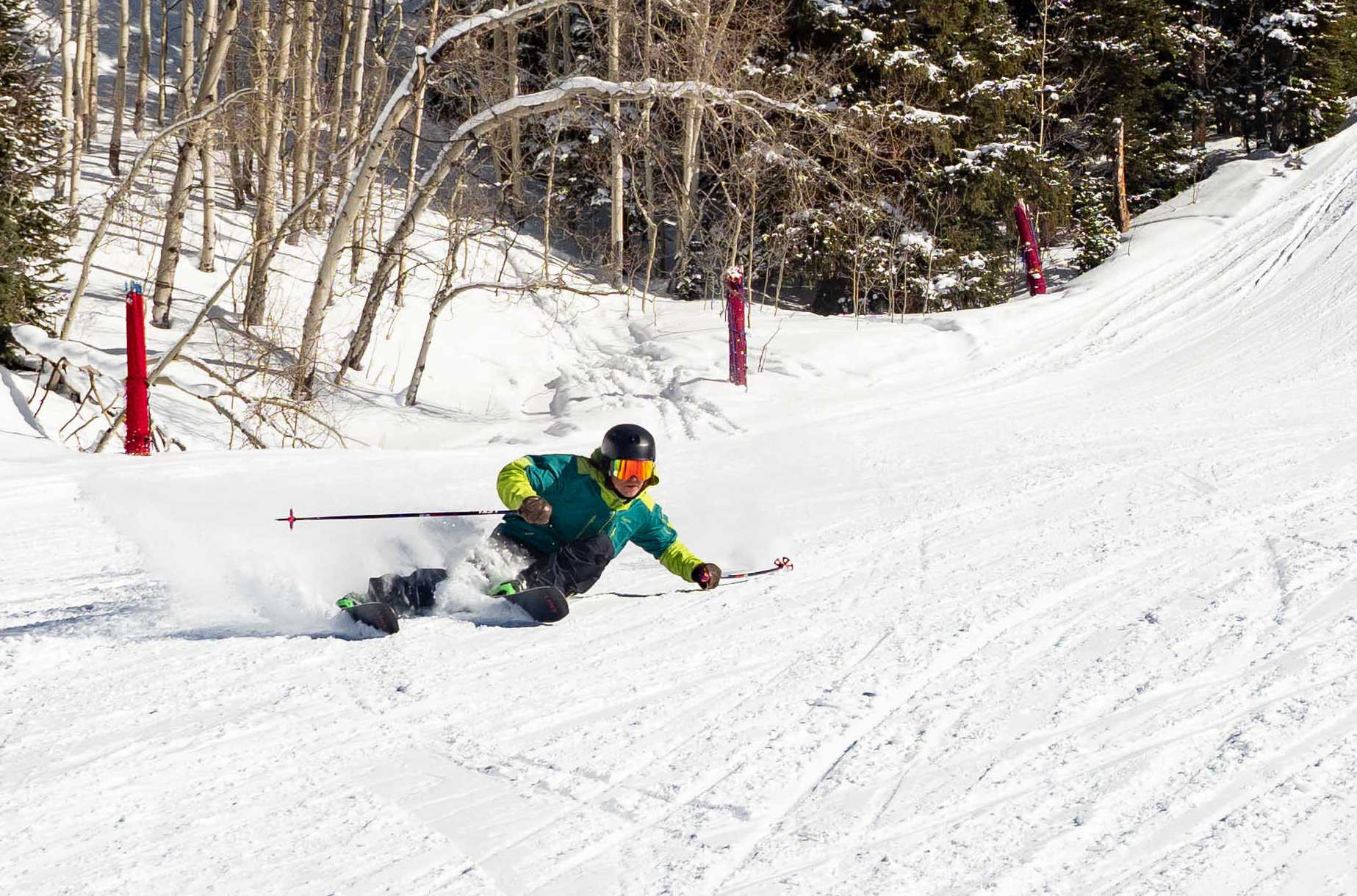
Supportive Referring to flex pattern; a stiffer ski is more supportive when the skier is driving / leaning into the ski quite hard. This is very dependent on the skier; a light, less aggressive skier might find a given ski to feel harsh or not engaging, whereas a bigger, more aggressive skier might find the same ski nicely supportive without feeling punishing or difficult to bend and engage.
Turn Initiation: This is a general term that describes how a ski behaves before and during the initial part of a turn. A ski that’s quick to initiate carved turns will start cutting across the fall line with minimal speed, slope angle, or forward pressure from the skier (this is closely related to how “engaging” a ski feels, at least in terms of carving). Some skis, typically those with very tapered or rockered tips, stiffer flex patterns, and/or longer sidecut radii, may not feel very quick to initiate a carved turn (we sometimes call this “vague” turn initiation), whereas minimally tapered tips, short sidecut radii, and softer flex patterns generally translate to easier, quicker turn initiation.
Maneuverable & Loose: We use these two terms fairly similarly, mostly to refer to how easily a ski lets you make a slarved, skidded, slashed, drifted turn. Very maneuverable or loose skis will not require much effort or focus to break them free from a carved turn, which can particularly be a big advantage in tight off-piste terrain (as well as deep snow), though this often comes at the expense of precision and edge hold on firm, smooth snow. We often use the term “loose” since it’s more specific to this ability to slide / skid / slarve / pivot, whereas “maneuverable” is a slightly more general term; we use the two mostly as synonyms, but “loose” leaves less room for ambiguity. More tip and tail taper, deeper rocker lines, reduced camber, increased degrees of reverse-camber, and softer flex patterns (torsionally & longitudinally) all tend to lead to a looser ski. A ski’s base and edge tune also play a significant role. In terms of how maneuverable a ski feels overall, you also have to factor in how quick / nimble / agile it feels (see below), among other things, which is why we always aim to describe how exactly a given ski feels “maneuverable.”
Forgiving: Skis that are forgiving are still fairly easy to steer and control when you make a mistake or are not skiing them with the best technique. Typically, this is most noticeable when you get “backseat” — i.e., you aren’t pressuring your boots with your shins, but instead leaning back on your calves. A ski that isn’t forgiving (i.e., it’s punishing and/or demanding), will make it challenging to stay in control and get back into a solid stance when you get backseat.
Accessible This term is closely related to “forgiving” and “engaging.” When we say a ski is accessible, we typically mean that it doesn’t require excellent technique, lots of physical effort, or high speeds to be enjoyable to ski. Skis that work well for beginners and intermediates are often pretty accessible, but can be enjoyed by skiers of all skill levels, depending on their personal preferences.
Demanding & Punishing: These two terms are closely related and generally refer to skis that aren’t all that easy to ski, particularly if you’re not a very experienced skier and/or not very physically strong. “Demanding” is a slightly broader term that can refer to both of those challenges, while we typically use the word “punishing” to describe skis that are very quick to discipline poor technique. A very heavy ski that’s also quite soft and rockered might be physically demanding to ski, but not punishing (e.g., J Skis Hotshot); a really stiff, minimally rockered, lightweight ski may not be very physically demanding to ski but could be very punishing (e.g., Atomic Vantage 97 Ti).
Flotation: Generally, this refers to how well a ski rises in and stays above fresh, soft snow. A ski doesn’t need to stay all the way on top of powder to be fun in deep snow, but what’s particularly important is how maneuverable it is in these conditions. If a ski offers very poor flotation and sinks through deep snow, it will be difficult to turn. Or if its tips suddenly sink when you hit some deeper snow, it might pitch your forward and throw you “over the handlebars.” Another thing to keep in mind is that skis with more rearward mount points will generally offer more flotation from the front of the ski (with the longer front of the ski rising up and the shorter back of the ski sinking down); this allows for the skier to put more pressure on the front of the ski in deep snow. Skis with more centered mount points will generally require a more centered stance, particularly in deep snow, but can still “float” fairly well if you’re accustomed to or adapt to the differences in stance.
Precise / Precision: If we say a ski is precise, we often mean that it offers good edge hold on firm snow and that it’s probably not super “loose” or eager to make slarved, pivoted, skidded turns. Precise skis generally reward skiers who prioritize good edge grip on firm conditions over maximum maneuverability. Shallower rocker lines, less tip and tail taper, and stiffer flex patterns (torsionally & longitudinally) all typically lead to increased precision.
Agile / Nimble / Quick: We use these terms pretty much interchangeably, and when we do, we’re mostly referring to a ski having a relatively low swing weight, so that it doesn’t require much physical effort to quickly and/or repeatedly flick from side to side or edge to edge. This is most noticeable in tight terrain like moguls and trees where rapid changes of direction are necessary, and also for freestyle skiers since it makes quick spins, swaps, and transitions easier. Edge-to-edge quickness is more specific to carving and how quickly you can switch from one set of your ski’s edges to the other (e.g., during a transition from a left turn to a right one); edge-to-edge quickness is impacted more by ski width than swing weight, with narrower skis offering better edge-to-edge quickness.

One of my favorite snow conditions is the “florist foam”, that low density but still firm snow that you can edge in well but it isn’t grabby. Mmmmm.
A few that didn’t make the list:
-Dust on crust
-Blower/Champagne
-Corn
-Ice (and it’s variations, blue to brown to white)
-Sastrugi
All of those should have been on the list. Especially dust on crust and blower (see also: nuking).
“Florist Foam”
I like that, it sounds better than Colorado (non)hardpack.
blue ice is a blast when you see it coming and make the choice to go on it and have a good outrun (yes i’m an east coaster how’d you know?)
How about slushies or slurpies? That super-soft and water-logged snow that you get later in the day during spring skiing.
This is great. While it’s not exactly stuff for a glossary, I’ve always wondered exactly what you guys meant by “fast” and “steep” etc. in objective terms. Do you mean “world cup downhill fast” like 80mph? It would be great to know.
Thanks,
Oliver
Hi, Oliver – “fast” and “steep” are pretty context-specific. So skiing “fast” in tight trees is quite different than laying down “fast” GS turns on a wide open groomer. One relative way to think of it, perhaps, is that “fast skiing” – whether in tight trees or down open groomers – means that you aren’t scrubbing much (or any) speed through turns — you’re keeping your speed or accelerating, as opposed to using your turns to control speed or scrub speed. In my reviews, at least, when I talk about a ski working well or not well at “moderate speeds.” So that doesn’t provide your objective definition, but hopefully helpful?
“Steep” is also relative, but hopefully makes sense when used in the context of a specific review. But it also is a bit conditions-specific – a “steep” icy groomer is almost certainly not as steep as the “steep” tree skiing in Taos’s West Basin, but both distinct situations put significant demands on the ski and on the skier, and the faster you’re skiing, the less margin for error there is. As a generalization, I tend to think of Copper Mountain (CO) as a fun not-steep mountain.
I’d love to see your definitions for terms like “playful,” “damp,” and “charger.”
Chalky
A firm surface that skilled carvers can really bite into yet less serious sliders frown upon and complain about icy conditions.
Steeze
Savvy, intuition derived from years of experience.
Just did the last two days of the season at Turoa Ski area Mt Ruapehu NZ. The last day began lazily watching the rugby World Cup then up the lifts to find most of the on-piste areas unworked from the day before so refrozen piles of slush with scraped icy patches between I called it non-groomers. Back to the cafe for another coffee and waited for it to soften then we started going wide and down skinning back out then in the afternoon wide and up for some magnificent runs in what I call icecream….rain-groomed smooth spring snow which has been frozen and the top 2-10 cm melts during the day …like cream cheese icecream can make pow seem a little overrated…back to the beach for summer now…Cheers Clive
Is “schmear” the same as “slarve”? Also, if not too much trouble, it might be helpful to add definitions of “butter” and other common freestyle moves just as a complete, central source for those new to the terrain park. Thanks.
Slarve/drift/surf/schmear. We could just go old school, and revert to the single term “skid”. :-)
I beg to differ, skidding back in the day was a hockey stop on hardpack. Twisting those bad boys across in powder ended up with the skier down.
New school funshapes are a new game.
I’ve been wondering about “tip taper” (as opposed to taper from tip to tail). Are there advantages beyond reduced swing weight? Does it make a ski less hooky in powder? Does it make a ski prone to deflection? Also wondering what deflection is. Is it the reverse portion of the sidecut forcing the ski to go the “wrong” way? I’ve never skied a tip-tapered model, and I’m curious.
By and large, if you remain on the piste tip taper means nothing and you will never feel the difference.
OTOH if you’re an off piste skier then the rocker shape with tip taper puts the wide spot closer to the forward contact point where it engages in a carve without hooking the tip on the mank, or chop. This makes pivoting easier and the tips slice easier under the snow with less hooking.
A dramatic taper is not necessarily a good thing when on crusty punchy layers as it penetrates that faster and gets you hung up underneath the crust.
Thanks, fellow Curb Your Enthusiasm fan. This off-piste skier appreciates it. Got a good deal on some Atomic Atlases to complement my Bodaciouses and was wondering how their coneheadedness might make them behave. Sounds like they’ll be fun in powder.
Um, actually it is a reference to Arrested Development.
Good lord, you’re right. My apologies, sir.
As I think I understand it, a squared tip with perpendicular edges will blast through (maybe over) crud with the help of a heavier ski with firmer heavier tips. On the other hand, the lighter, more rounded or pointer tips get knocked side to side by chop/crud. The pointier tips are at an angle to the chop and crud which deflect the tips to the sides. I might think of it kind of like the angle of a rudder moving the tail of a boat side to side to force a turn, only in reverse on the tips. Your tips get knocked left and right and unevenly making your tips “squirelly” and unpredictable. I could compare it to asquirrels cutting into deep sand getting squirrely. If your an off reader, I might compare it a bit to Death Wobble.
Your term “hooky” is applicable. I would have to say Death Wobble (Jeeps) or tank slapping (motorcycles) would be more inline with less tip weight and more rocker (or reverse camber) causing tip unstability at higher speeds.
Haha, I was trying to compared a bike tire cutting into sand and getting pushed ir turned side to side but, the dang auto-correct changed it to “asquirrels”.
As an east coaster… I think you need to differentiate between bulletproof and ice.
Colorado/Utah/etc skiers are spoiled. You can get an edge on bulletproof, you just can’t finish turns properly. Yeah, it sucks.
True ice stands out from the surrounding snow for its color (blue, dark, or clear) and there’s nothing you can do but ride through it. And fortunately it basically does not exist once you hit the Rockies.
This is awesome. Have to add one though. My favorite condition is a rare hybrid in the spring, 2-4″ of dense fresh snow on top of a soft corn that hadn’t refrozen from the day before so the snow stays fast the next morning. I call it “Creamed Corn.”
hi Guys this is amazing vocab you got there! Some of those are Americanisms which make it even funnier to use! cheers from UK
To nitpick: For me, crud doesn’t NEED to be refrozen or set-up overnight; I see a same-day continuum from Powder to Chop to Crud, which is simply the stuff left over after snow has been truly beat up by traffic. Chop suggests there are still small pockets of pow; Crud may still be 3D but everything has been touched at least once or several times.
i would like to amend the sastrugi assessment. the skiability of it depends entirely on the conditions. here in the PNW, we often get sastrugi that is fairly uniform in its wave structure. if the snow is akin to an old school styrofoam cooler in density(kinda like sam shaheen’s florist foam but a hair looser), MAN ! that stuff rocks ! no speed limit, just enough variability to keep you honest, actually provides a great rhythm under yer feet, and it is so gorgeous to look at… LOVE IT !
“Suspension”. Reviews use that term a lot, but I’m not clear on what it means in relation to smooth and stable.
Good question — we use it almost interchangeably with “damp” or “damping,” but overall when we talk about “suspension” we’re referring to how well the ski absorbs impacts and vibrations, rather than those impacts and vibrations being felt by your feet, legs, etc. A ski with excellent suspension (a ski that’s very damp) can be skied in rough conditions with little “feedback” or harsh impacts transmitted to your body (i.e., the ski will feel “smooth”). A ski with poor suspension will feel pretty harsh, chattery, rough, etc. on rough snow conditions.
Love the post…..American English is great……Two types of snow we can get in CO, at times (usually late winter and early spring) are: 1) Styrofoam snow. When one skis it they ramp up on it and then sink into it in countable, almost rhythmic, intervals. It is impossible to carve or even slave a turn. Of course it is horrible to ski. 2) Waxy snow. It is a snow that sets up with lots of water in it but appears (to the eye) to be packed powder. But clearly is not. It is almost impossible to carve a turn in as it is very packed and dense. No give and can feel sticky to a sharp edge on the ski. It is most horrible when a small powder day turns into this and is coupled with push piles. One can test for this by pushing the pole into the snow and then levering on it. If the snow does “give” it will pop out a square -shaped “plug” of snow. This is the stuff.
Skied some pudding a few years back over at Powder Mtn. It would have been corn had the sun come out, but it didn’t. It still warmed up enough to soften up. 2 to 3 inches of soft, real soft and smooth and easy on the knees, and real ego snow too! Easy to carve, hard to go wrong, a top 5 condition for me.
A couple more:
runnels – erosion patterns on the snow surface from water runoff
elephant snot – cake batter/cream cheese style snow
chunder – large chunks of snow and ice typically left behind by snowcats and during freeze-thaw cycles
Not sure these are synonyms. Cake batter/cream cheese sound “nice”, whereas “elephant snot” is generally so heavy and dense as to be verging on cement. It wears out anyone’s legs really fast, and is therefore not nice. :-)
Hi, how would you describe or define the term “centered stance”? You use this term quite often when describing how to ski a certain ski.
Best regards,
obi
I would think centered can be two things. I think they mostly refer to not leaning forward pressuring the tips or backward pressuring the tails but rather standing upright in between. The other way would be how far forward or rearward the bindings are mounted causing the same front or rear pressure differences (bias). When I made the decision to buy Fischer Ranger 102s, after renting and then reading Blister’s recommendation on a forward mount to make them more playful, I had them mounted forward to Blister’s spec. In my opinion that ruined the skiability because the tips were too squirelly and hooky and on steep off-piste I always felt like I would go over the tips at any moment and had to practically sit back on the tails. At even moderate speeds on groomers the tips often felt out of control for me. I had them recounted to the factory recommendation and prefer them that way. Like they often say, “your experience may vary” based on many variations and preference of each skier.
I encountered what I heard referred to years ago as “rotten” snow at A-Basin last spring. That would be spring snow that has been hollowed out by water from the melting surface seeping through base snow underneath that creates all sorts of empty space within it. I was having fun making turns on my rocker fatty’s and broke right through up to my knees at one spot. It was pretty much an instantaneous stop.
Interesting–I always think of “rotten” snow as all facets, from the top of the snow accumulation to the ground. AKA “recycled pow.”
Here in New Zealand, resorts often report they have an abundance of ‘packed powder’. It is often very well-packed. Do you get this in the States too?
Oh yes! Here in Colorado we get “Packed Powder” about three days after a storm when there is no powder left to find. It lasts until we get more spring-like conditions where it warms up during the day and freezes at night, or it becomes so cold for a few days that the groomers really can’t break it up. It then becomes “hard pack” or even “boilerplate”. Packed powder as reported by the resorts can last for weeks.
I am missing cauliflowers! Otherwise, great job.
I am having a sentimental moment remembering the term “fun shape,” last seen around 2013.
For the “Performance Traits” section above, I’d like to see a definition for what people mean when they say “balance” and/or “the right balance” for a ski.
In Episode 202 of Gear:30 podcast, Jonathan and guest A.J. (of Rossi) say “balance” 10 times, but it’s not clear to me what that means. Do they mean fore/aft balance? Or maybe balance between many on-snow performance metrics? Or maybe balance between all the precise goals written in the design brief? Or what?
I thought of another one. In podcasts and prose, Blister has used the word “planted” to describe a ski. What is meant by that?
I understand what a pole “plant” is, but I don’t understand what people mean when they refer to a moving ski, sliding thousands of feet down a snow surface, as “planted”, or “more planted” than a different ski.
The term “strong” is used in ski descriptions but is not in the glossary.
Could you talk more about what you mean by “surfy” in the buyer’s guide? Is it always tied to how well the edge releases (since one of the spectrums is most least surfy/loose)?
Hi, would be interesting to hear your thoughts on shape, width etc for different snow types. As an example I’m currently looking for a 50/50 ski. Currently ski mostly in scandinavia were we get quite much wind affected snow, refroxen and breakable crust. What would be best shape to look fore, little/much taper, rocker? Overall flex?